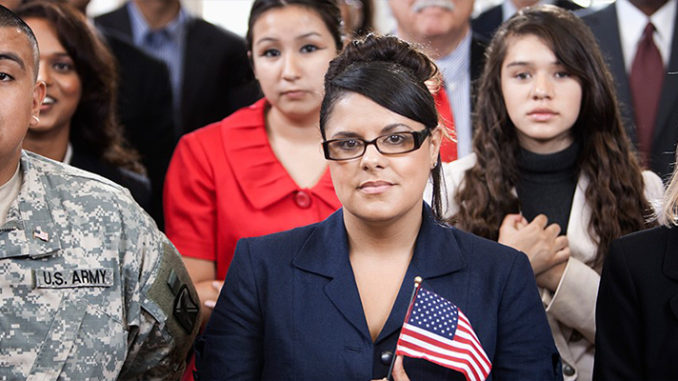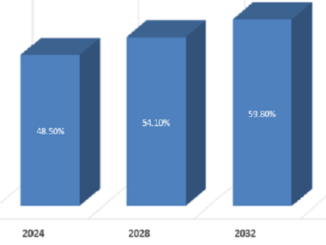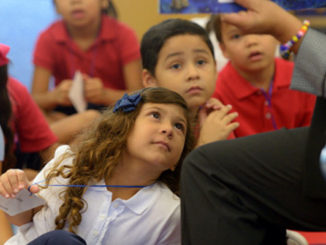
by William H. Frey
The Census Bureau reported last month that the nation’s white population declined for the first time. This dip was previously not projected to begin until the next decade, though it will continue for much of this century.
Many white supporters of President Trump will view this as yet another sign of the end of the America they know, as the country inches toward “majority-minority” status. To them, this means relinquishing dominance and privileged status to browner and newer Americans, whom they perceive as competing with them for jobs and government resources, while distorting their way of life. This “white anxiety” underlies many proposals from Trump, such as the Mexican border wall and Muslim ban, along with his derogatory statements against immigrants and political correctness — all to display a pushback against demographic change.
Yet the real national damage from the decades-long white population loss that is almost certain to occur is the negative impact on our economy that will emanate from the politics of white anxiety — politics that will lead to a disinvestment in our growing young minority populations that are crucial to our prosperity.
It is the younger part of the population where minority investment is most crucial. This is because white population loss is occurring most heavily among the youth — a consequence of white aging and fewer white women in their childbearing years. Since 2000, there has been an absolute decline of the number of white children under 18 nationally — a trend that will continue in the foreseeable future along with projected losses in white 20-somethings and eventually 30-somethings.
In fact, it is the combined racial minority population, especially Latinos, that accounts for all of the growth in the nation’s population under the age of 25, nearly half of public school students, and the majority of all children under the age of 10. As more older whites retire, racial minorities will comprise all of the growth in our working-age population. From a demographic standpoint, the infusion of youthful minorities from both immigration and births is a windfall that will save us from the kinds of labor force losses that Japan and several European countries are now experiencing.
However, this demographic windfall will not bear fruit unless we make educational and other investments in today’s multicultural youths. Too many minority children attend under-resourced, segregated schools and do not receive the guidance or finances to attend two- or four-year colleges that provide pathways to well-paying jobs. Four-year college enrollment numbers for Latinos and blacks, while rising, stand well below those of whites, which could lead to declines in future generations’ education attainment. And many come from families that are struggling with high poverty levels, making it difficult to arrange family leave, child care and other support. Major public interventions are necessary to improve the educational outcomes and well-being of future generations.
Yet expanding such interventions is not likely in the current political environment, where the older whiter population holds considerable voting heft and is most strongly on board with a Trump agenda that hardly places a priority on the well-being of immigrant and minority children.
Ironically, it is the older white population that would benefit handsomely from investments in the labor force skills of younger minorities — by way of the latter’s contribution to Social Security and Medicare. Due to the aging of Baby Boomers, those of retirement age are the only part of the white population that will show substantial gains (32 percent) over the next 15 years. In so doing, they will contribute mightily to record levels of age dependency in the U.S., relying on younger, racially diverse generations to contribute adequately to the safety net programs that they will depend on.
For the near term, however, there seems to be a cultural generation gap where fearful older whites seem unwilling to embrace a multihued younger generation whom they do not view as their children or grandchildren. This gap began well before Trump, as the older white generation has been less likely than minorities or younger whites to see the nation’s growing diversity in a positive light. A 2012 Pew survey showed that more than half of white Baby Boomers and seniors believed that increasing numbers of newcomers from other countries represented a threat to traditional American values. Also, a 2016 survey showed whites over age 50 to be decidedly unsupportive of the Black Lives Matter movement compared with younger generations. Not surprisingly, whites over the age of 45 were the strongest supporters of Trump in the 2016 election.
This gap in attitudes is unfortunate because it is counterproductive for older whites to view today’s growing racially diverse America as a threat to them or the nation. The demographics make plain that they have a co-dependent relationship with today’s younger, majority-minority generations. As a consequence, they and everyone else will need to count on growing populations of young minorities — Latinos, blacks, Asian Americans and other groups — to be primary contributors to the labor force, tax base and consumer base in decades to come.
White anxiety should be redirected toward ensuring that the next generation of Americans — of all hues — have everything they need to be successful and, in the process, are well-equipped to keep America great.
William H. Frey is senior fellow at the Brookings Institution and population studies professor at the University of Michigan. An updated edition of his book “Diversity Explosion: How New Racial Demographics are Remaking America” is available.



